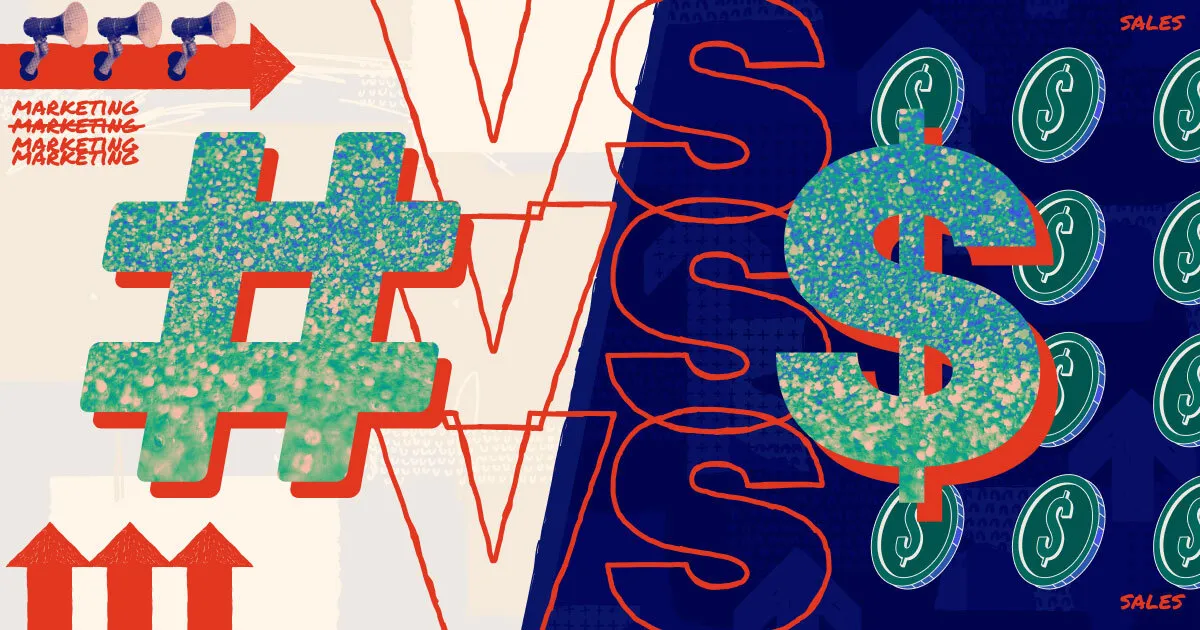If you want to get people to buy your product so that you can earn revenue and grow your company, they need to know about that product first. That’s where marketing and sales teams come in. Their job is to get the word out and to bring the customers and prospects in.
But while their ultimate goal – to help grow your company – is the same, the ways they go about reaching this goal is quite different. Understanding how marketing vs sales operates will help you create strategies to leverage their strengths, find the best ways to take advantage of overlaps and to structure your sales and marketing departments in the best way for your business and your unique needs. So how do they differ?
Marketing vs. sales: The function
Marketing departments have one main function: to attract your target audience. They do this by creating awareness of your product and brand identity, emphasizing what the product can do and how it can make the potential customer’s life easier. So, they create leads. You can look at it this way: marketing creates the bait that will draw the target audience closer. Marketing is a longer game.
Sales departments seal the deal. In other words, they use the bait to hook the customer. They follow up on the marketing qualified leads, identify potential customers and get them past the line to a closed deal.
Marketing vs. sales: The approach
In order to create awareness of the brand and the product, marketing takes quite a broad approach. Marketers essentially casting the net to generate leads, so they shouldn’t be too niche or specific. Building a brand is key when it comes to an ability to attract a share of a target or particular market — and the knowledge and awareness of a brand is ultimately driven by good marketing.
Marketers also tend to have more pull-focused (inbound) marketing strategies, although elements of push (outbound) are present too. A strong marketing strategy will use a range of techniques to create awareness:
- Digital marketing such as search-engine optimization or SEO
- PPC or pay-per-click
- Email marketing and content marketing including blogs and podcasts
- Influencer marketing or affiliates
- Programmatic advertising through ad exchanges
- Advertising in electronic and print media
- Other forms of print marketing, such as flyers
- Public relations
- Events and activations
The ratio in which to use these depends on factors like the target audience you want to reach and the marketing environment — you need to continuously revise and adapt your strategy.
Sales takes a more targeted approach that focuses more on push (outbound) than on pull (inbound). They already have their eyes on potential customers, so they need to find ways to hone in on those target audiences and convince them to subscribe, renew their subscription and upgrade. Their sales strategy includes techniques like direct messaging through email or LinkedIn, cold calling and in-person networking.
Once they’ve established a relationship with a potential or existing customer, they need to continuously nurture that relationship to build the customer’s trust and loyalty. Like marketing, they need to be able to adapt their strategy when needed.
Related: Inbound vs. outbound partner recruitment strategies.

Marketing vs. sales: The focus
Marketing teams tend to look at the bigger picture. They want customers to become loyal to the brand, so that when those customers are looking to buy a new product, they’ll look at the range of products the specific brand has to offer rather than going elsewhere.
This is especially important to remember in the B2B SaaS arena, where the goal is to retain and even upsell customers. So, marketing will not simply focus on what the customer needs right now but will look at what the customer might want in future. They will communicate the customer’s desires to the development team, who can then create new products.
Sales is less concerned with the big, long-term picture and more with the here and now, like hitting quarterly sales targets. After all, a customer doesn’t make purchasing decisions now based on what might fulfill their needs a few months; they sign on based on what will meet their needs right now.
Marketing vs. sales: The goals
Because marketing is more focused on creating awareness, marketing goals tend to be more abstract as they're more closely tied to leads than to revenue. For example, they may include researching what customers need and want, improving brand recognition, launching new products, generating new leads and nurturing existing ones, establishing and maintaining customer relationships and building customer loyalty. These goals can be harder to measure because they don’t generally have an immediately visible impact on revenue.
Sales’ goals tend to be more tangible, which makes them more easily measurable too. They tend to focus on targets: the number of sales, the amount of revenue generated, the number of subscriptions renewed, profit margins, and the like. These targets are usually set for shorter periods too, making it easier to see the immediate impact of a specific sales strategy.
Marketing vs. sales: The process
In short, marketing’s process is to identify their brand or product’s competitive advantage, identify their target market and find ways to communicate with that target market. So, they start with research of what’s available in the market, what potential customers are looking for and how they can give those potential customers what they want.
Marketers tend to divide their customers into different segments according to their similarities and differences and then look for the best ways to reach each of these categories. Using this information as well as the features that make their product or brand stand out from the rest, they develop marketing campaigns.
When measuring the success of these campaigns, they look at sales figures – for instance, the number of new subscriptions and package upgrades – but they also look at a variety of other metrics like user traffic, time spent on the website, engagement on social media and how these change over time.
For sales, the process starts with getting to know the product itself: its features and how it will benefit the potential customer. Once they have this information, they identify potential customers, connect with them, for example through cold calling or email drip campaigns. Sales teams then evaluate the responses they get to qualify which potential customers to focus on.
Once qualifies, sales will approach those potential customers to meet with them and demonstrate the product and address any concerns the potential customer may have. Finally, as they move the customer through the sales funnel, they will negotiate the service level agreement, deliver the product and follow up with after-sales service to retain the customer.
See also: What to know about high-touch vs. low-touch sales funnels.

Marketing and sales: How do they work together?
Just because they have different roles doesn’t mean that sales and marketing should work as separate entities. In fact, in smaller businesses, the sales and marketing functions are often performed by the same team rather than two departments. Without sales and marketing alignment, your business won’t generate sales like you want it to and you can forget about increasing revenue.
Marketing isn’t better than sales and you don’t make more money through marketing. Neither is it better to focus on sales or think that you will make more money in sales. The two functions are equally important and one cannot exist without the other. If marketing doesn’t create the right message to bait the potential buyer, sales won’t be able to hook that buyer and turn them into a customer. But without feedback from sales, marketing won’t know what the right message is in the first place.
In the B2B SaaS space, both sales and marketing teams face an extra challenge: instead of landing that customer for a one-off sale, they need to get them to buy a subscription, stay loyal to the product, renew their subscription and upgrade to a better package. So, they need to work together to find ways to continuously bait and hook, bait and hook for your company to grow. And growing the company is ultimately both teams’ main goal.
Integrating sales and marketing efforts
Marketing and sales can work together collaboratively to have greater business alignment and save resources. For example, they can collaborate to create enablement materials and messaging for partners that reflect the brand messaging and also help close deals. And as mentioned above, working collaboratively to create feedback loops between sales and marketing can help hone in on the exact right message to deliver to market.
When marketing and sales teams have tasks that ladder up to the same broader company goals, it will be easier for the two departments to find better alignment.
Using technology to bridge sales and marketing
Another effective way to bridge the gap between marketing and sales is to ensure that they not only have similar goals, but they also speak the same language within the business. This means working with a tech stack that helps support both marketing and sales; a CRM system that can support the functionalities needed by both, and automation tools that serve sales and marketing by saving time that can then be re-invested into strategic development.
See more: Here's how business automation saves you time and money.
Where do partnerships fall into this equation?
If marketing's role is to build awareness and drive leads for the direct sales team to generate pipeline and close more deals, then the role of partnerships is to do a bit of everything, or so it seems.
Partnerships can often times feel like a start-up within the business, as they’re supporting the needs of partners (playing the role of customer success and onboarding), promoting and developing enablement materials to drive leads (the role of marketing) and lastly, working with partners to co-sell a deal (the role of a sales).
Indirect sales (through partnerships) have potential point of friction and confusion with the traditional direct sales engines you’ve built if your attribution methods aren't well-established so each channel can accurately track the revenue they're driving. But when it’s working, your revenue metrics will speak for themselves. Plus, sales teams can leverage partners to help close deals by bringing in trusted partners who potential customers may already have relationships with, or creating co-marketing opportuities to help support marketing priorities.
This article was originally published in June 2022.


















